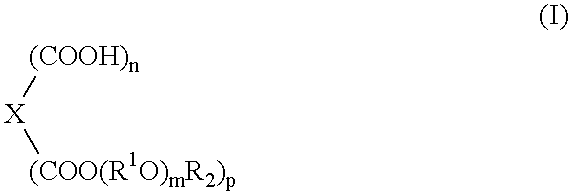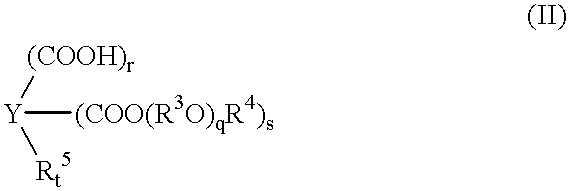Additive for rubber composition, additive composition for rubber composition, rubber composition and tire
a technology which is applied in the field of additive composition and additive composition for rubber composition, can solve the problems of unfavorable plasticization operation, degradation of properties of uncured rubber composition or cured rubber composition, and unfavorable rubber article productivity
- Summary
- Abstract
- Description
- Claims
- Application Information
AI Technical Summary
Benefits of technology
Problems solved by technology
Method used
Image
Examples
examples 15-27
, Comparative Examples 3-9
An uncured rubber composition is prepared by compounding 100 parts by weight of rubber ingredient shown in Table 5 with the kind and amount of the above additive for a rubber composition shown in Table 5, 50 parts by weight of carbon black ISAF, 2 parts by weight of stearic acid, 3 parts by weight of zinc white, 1 parts by weight of an antioxidant 6 PPD, 1.5 parts by weight of sulfur and 1 part by weight of a vulcanization accelerator CBS. The resulting uncured rubber composition is kneaded 3 times. Moreover, the kneading number in Comparative Example 3 is 4 times.
With respect to the thus obtained uncured rubber composition, the processability (Mooney viscosity), processing stability (Mooney scorch time), vulcanizing property (T90) and odor are evaluated to obtain results as shown in Table 5. Comparative Example 3 is set to be control in the properties for all of the examples and the comparative examples.
The rubber composition of Comparative Example 4 is po...
production examples 1-11 (
Additive composition for a rubber composition)
An additive composition for a rubber composition is prepared by mixing silica, carbon black as a component (a) with an ester of an aromatic polyvalent carboxylic acid and a (poly)oxyalkylene derivative as a component (b) and a (poly)oxyalkylene derivative or a polyvalent alcohol aliphatic acid ester having a melting point of not higher than 20.degree. C. and a boiling point of not lower than 150.degree. C. as a component (c) according to a compounding recipe as shown in Table 6 in a Henschel mixer while stirring. The property of the resulting additive composition is also shown in Table 6.
The additive compositions of Production Examples 1-10 according to the invention are solid and are easy to handle Particularly, in the additive compositions of Production Examples 3-8, 10, since the component (c) is added, the powdery duct is hardly scattered because these compositions are rendered into the granulated powder being more advantageous in th...
examples 28-41
100 parts by weight of rubber ingredient shown in Table 7 is kneaded with the additive compositions of Production Examples 1-10 of kind and amount shown in Table 7 (compounding amount is shown as an amount of component (b) in the composition), 50 parts by weight of carbon black ISAE, 2 parts by weight of stearic acid, 3 parts by weight of zinc white and 1 part by weight of an antioxidant 6 PPD, and then 1.5 parts by weight of sulfur and 1 part by weight of a vulcanization accelerator CBS as a vulcanizing additive are added and then the kneading is carried out at the number shown in Table 7 to obtain a rubber composition.
With respect to the thus obtained rubber compositions, the Mooney viscosity (processability), Mooney scorch time, vulcanizing property and odor are evaluated to obtain results as shown in Table 7.
PUM
| Property | Measurement | Unit |
|---|---|---|
| carbon number | aaaaa | aaaaa |
| carbon number | aaaaa | aaaaa |
| nitrogen adsorption specific surface area | aaaaa | aaaaa |
Abstract
Description
Claims
Application Information
 Login to View More
Login to View More - R&D
- Intellectual Property
- Life Sciences
- Materials
- Tech Scout
- Unparalleled Data Quality
- Higher Quality Content
- 60% Fewer Hallucinations
Browse by: Latest US Patents, China's latest patents, Technical Efficacy Thesaurus, Application Domain, Technology Topic, Popular Technical Reports.
© 2025 PatSnap. All rights reserved.Legal|Privacy policy|Modern Slavery Act Transparency Statement|Sitemap|About US| Contact US: help@patsnap.com



